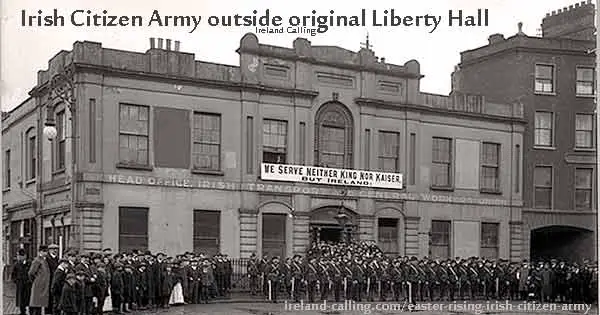The Irish Citizen Army (ICA) was a small but well trained paramilitary group that was originally set up to protect trade unionists in Dublin from police aggression. It went on to play a prominent role in the Easter Rising of 1916 under the leadership of James Connolly.

In 1913, Dublin was paralysed by a bitter dispute involving employers and members of the Irish Transport and General Workers’ Union. The union had been set up by the militant socialist and brilliant orator, James Larkin.
Employers became alarmed at Larkin’s success in recruiting members to the union. Matters reached a head when the industrialist William Martin Murphy locked out a number of workers because they refused to leave the union.
Irish Citizen Army formed to protect trade union members
This led to strikes and further lockouts until eventually there were more than 400 employers and 25,000 workers involved. The dispute lasted six months before the workers were starved into submission and agreed to return to work on the employers’ terms.
During the lockout there were numerous incidents in which the police were accused of brutality towards unionists as they broke up meetings and demonstrations.
Larkin responded by setting up the Irish Citizen Army to protect his members and make the police think twice before staging baton charges.
Following the Lockout, Larkin felt bitter, exhausted and in need of a break. In October, 1914 he left for a speaking tour of the United States, leaving James Connolly in charge of the union.
James Connolly becomes Commandant of the ICA
Connolly also became Commandant of the ICA and saw that it could be used to stage an uprising against the British. He encouraged members to drill and undertake military training under Captain Jack White from Co Antrim, who had served in the British Army and been educated at the prestigious Sandhurst military college.
White was arrested in March 1914 and later resigned as commander. Sean O’Casey, who would later become one of Ireland’s leading playwrights, was a member of the ICA at this time and wrote a constitution designed to take it on a stage further from its original role within the union. Its guiding principle would be that “the ownership of Ireland, moral and material, is vested by right in the people of Ireland”.
Connolly added political instruction to the military training, emphasising the need for discipline in the pursuit of Irish independence. A recruiting poster for the ICA stressed that it was pledged to “work for, organise for, drill for and fight for an independent Ireland”.
ICA monitored by British authorities
With such unequivocal aims it was not surprising that the British authorities were concerned and monitored members closely, especially as they marched and practised their drills in the open on the streets of Dublin.
However, the authorities generally chose to tolerate the ICA’s military exercises, fearing that to stop them would provoke more trouble. Close monitoring was considered the best option.
In spite of this surveillance, Connolly was able to plan a rebellion without arousing too much suspicion and used his union headquarters at Liberty Hall to store arms. By 1915, Michael Mallin had taken over from White as Chief of Staff and the ICA had become a competent, military force with admirable levels of training and discipline.
ICA join forces with Irish Republican Brotherhood
Independently of Connolly, Patrick Pearse and the Military Council of the Irish Republican Brotherhood (IRB) were also planning a rebellion. In January, 1916, Pearse became aware of Connolly’s plans and met with him to urge him not to act alone or too soon.
Starting on 19 January, Connolly and the Military Council spent three days locked in talks. They eventually agreed to pool their resources and stage a joint rebellion. Connolly joined the IRB’s Military Council and played a major part in planning the Easter Rising, which would now feature the Irish Republican Brotherhood, Irish Citizen Army and the Irish Volunteers.
There were only 219 soldiers in the ICA during the Rising but they were the best trained and most cohesive unit.
Some accompanied Pearse in the GPO, but most served with Mallin at St Stephen’s Green/College of Surgeons, while others served at Dublin City Hall. There was also a detachment at Harcourt Street railway station.
Several ICA members lost thir lives during and after the Rising
Eleven ICA men were killed during the Rising, including one of its officers Seán Connolly, the first rebel casualty.
The ICA was only rebel force that accepted female recruits so a number of women joined their ranks. The best known was the Countess Markievicz who became Honorary Treasurer and acted as second in command to Michael Mallin at St Stephen’s Green.
The ICA’s two main leaders, Connolly and Mallin, were both executed after the Rising. Many ICA members later joined the IRA and took part in the War of Independence. It ceased to be a major military force in its own right, but former members donned uniforms again to provide a guard of honour at the funeral on Countess Markievicz in 1927, and again at the funeral of James Larkin in 1947.
easter-rising.html